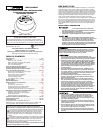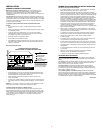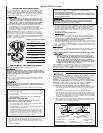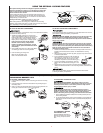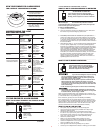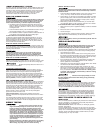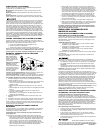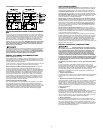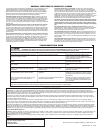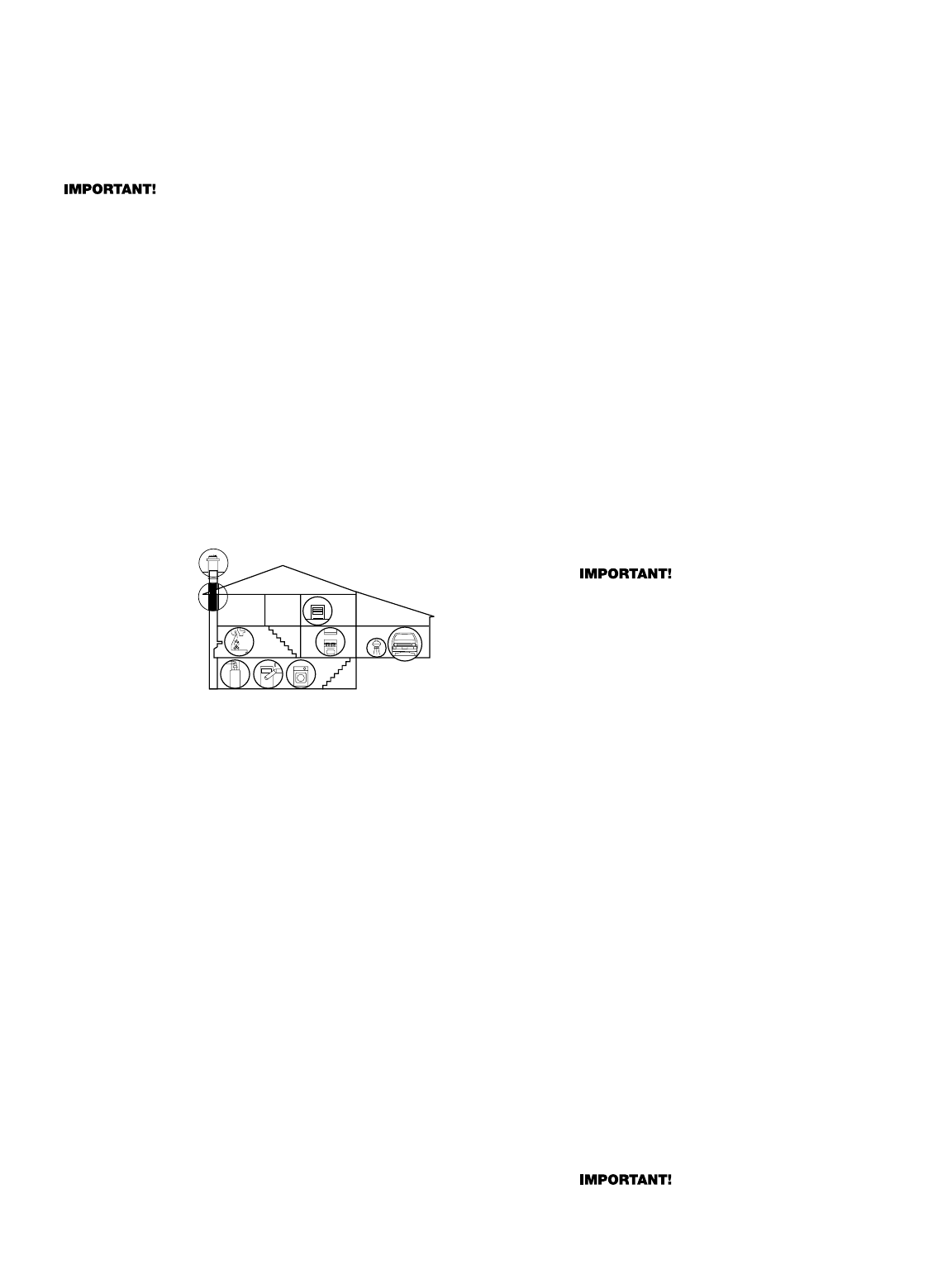
7
SYMPTOMS OF CO POISONING
These symptoms are related to CO POISONING and should be dis-
cussed with ALL household members.
Mild Exposure: Slight headache, nausea, vomiting, fatigue (“flu-like”
symptoms).
Medium Exposure: Throbbing headache, drowsiness, confusion, fast
heart rate.
Extreme Exposure: Convulsions, unconsciousness, heart and lung
failure. Exposure to Carbon Monoxide can cause brain damage, death.
This Smoke/CO Alarm measures exposure to CO over time. It alarms if
CO levels are extremely high in a short period of time, or if CO levels
reach a certain minimum over a long period of time. The Smoke/CO
Alarm generally sounds an alarm before the onset of symptoms in aver-
age, healthy adults. Why is this important? Because you need to be
warned of a potential CO problem while you can still react in time. In
many reported cases of CO exposure, victims may be aware that they
are not feeling well, but become disoriented and can no longer react
well enough to exit the building or get help. Also, young children and
pets may be the first affected. The average healthy adult might not feel
any symptoms when the Smoke/CO Alarm sounds. However, people
with cardiac or respiratory problems, infants, unborn babies, pregnant
mothers, or elderly people can be more quickly and severely affected by
CO. If you experience even mild symptoms of CO poisoning, consult
your doctor immediately!
FINDING THE SOURCE OF CO AFTER AN ALARM
Carbon monoxide is an odorless, invisible gas, which often makes it
difficult to locate the source of CO after an alarm. These are a few of the
factors that can make it difficult to locate sources of CO:
• House well ventilated before the investigator arrives.
• Problem caused by “backdrafting.”
• Transient CO problem caused by special circumstances.
Because CO may dissipate by the time an investigator arrives, it may be
difficult to locate the source of CO.
BRK Brands, Inc. shall not be obli-
gated to pay for any carbon monoxide investigation or service call.
POTENTIAL SOURCES OF CO IN THE HOME
Fuel-burning appliances
like: portable heater,
gas or wood burning
fireplace, gas kitchen
range or cooktop, gas
clothes dryer.
Damaged or insufficient
venting: corroded or
disconnected water
heater vent pipe, leaking
chimney pipe or flue, or
cracked heat exchanger,
blocked or clogged
chimney opening.
Improper use of appliance/device: operating a barbecue grill or vehi-
cle in an enclosed area (like a garage or screened porch).
Transient CO Problems: “transient” or on-again-off-again CO problems
can be caused by outdoor conditions and other special circumstances.
The following conditions can result in transient CO situations:
1. Excessive spillage or reverse venting of fuel appliances caused by
outdoor conditions such as:
• Wind direction and/or velocity, including high, gusty winds. Heavy
air in the vent pipes (cold/humid air with extended periods
between cycles).
• Negative pressure differential resulting from the use of exhaust
fans.
• Several appliances running at the same time competing for limited
fresh air.
• Vent pipe connections vibrating loose from clothes dryers,
furnaces, or water heaters.
• Obstructions in or unconventional vent pipe designs which can
amplify the above situations.
2. Extended operation of unvented fuel burning devices (range, oven,
fireplace).
3. Temperature inversions, which can trap exhaust close to the ground.
4. Car idling in an open or closed attached garage, or near a home.
These conditions are dangerous because they can trap exhaust in your
home. Since these conditions can come and go, they are also hard to
recreate during a CO investigation.
HOW CAN I PROTECT MY FAMILY FROM CO
POISONING?
A Smoke/CO Alarm is an excellent means of protection. It monitors the
air and sounds a loud alarm before Carbon Monoxide levels become
threatening for average, healthy adults.
A Smoke/CO Alarm is not a substitute for proper maintenance of
home appliances.
To help prevent CO problems and reduce the risk of CO poisoning:
• Clean chimneys and flues yearly. Keep them free of debris, leaves,
and nests for proper air flow. Also, have a professional check for
rust and corrosion, cracks, or separations. These conditions can
prevent proper air movement and cause backdrafting. Never
“cap” or cover a chimney in any way that would block air flow.
• Test and maintain all fuel-burning equipment annually. Many local
gas or oil companies and HVAC companies offer appliance
inspections for a nominal fee.
• Make regular visual inspections of all fuel-burning appliances.
Check appliances for excessive rust and scaling. Also check the
flame on the burner and pilot lights. The flame should be blue. A
yellow flame means fuel is not being burned completely and CO
may be present. Keep the blower door on the furnace closed. Use
vents or fans when they are available on all fuel-burning appli-
ances. Make sure appliances are vented to the outside. Do not
grill or barbecue indoors, or in garages or on screen porches.
• Check for exhaust backflow from CO sources. Check the draft
hood on an operating furnace for a backdraft. Look for cracks on
furnace heat exchangers.
• Check the house or garage on the other side of shared wall.
• Keep windows and doors open slightly. If you suspect that CO is
escaping into your home, open a window or a door. Opening win-
dows and doors can significantly decrease CO levels.
In addition, familiarize yourself with all enclosed materials. Read
this manual in its entirety, and make sure you understand what to
do if your Smoke/CO Alarm sounds.
REGULATORY INFORMATION FOR
SMOKE/CO ALARMS
REGULATORY
INFORMATION FOR CO ALARMS
WHAT LEVELS OF CO CAUSE AN ALARM?
Underwriters Laboratories Inc. Standard UL2034 requires residential CO
Alarms to sound when exposed to levels of CO and exposure times as
described below. They are measured in parts per million (ppm) of CO
over time (in minutes).
UL2034 Required Alarm Points*:
• If the alarm is exposed to 400 ppm of CO, IT MUST ALARM
BETWEEN 4 and 15 MINUTES.
• If the alarm is exposed to 150 ppm of CO, IT MUST ALARM
BETWEEN 10 and 50 MINUTES.
• If the alarm is exposed to 70 ppm if CO, IT MUST ALARM
BETWEEN 60 and 240 MINUTES.
* Approximately 10% COHb exposure at levels of 15% to 95% Relative
Humidity (RH).
The unit is designed not to alarm when exposed to a constant level
of 30 ppm for 30 days.
CO Alarms are designed to alarm before there is an immediate life
threat. Since you cannot see or smell CO, never assume it’s not present.
• An exposure to 100 ppm of CO for 20 minutes may not affect aver-
age, healthy adults, but after 4 hours the same level may cause
headaches.
• An exposure to 400 ppm of CO may cause headaches in average,
healthy adults after 35 minutes, but can cause death after 2 hours.
Standards: Underwriters Laboratories Inc. Single and Multiple Station
carbon monoxide alarms UL2034.
According to Underwriters Laboratories Inc. UL2034, Section 1-1.2:
“Carbon monoxide alarms covered by these requirements are intended
to respond to the presence of carbon monoxide from sources such as,
but not limited to, exhaust from internal-combustion engines, abnor-
mal operation of fuel-fired appliances, and fireplaces. CO Alarms are
intended to alarm at carbon monoxide levels below those that could
cause a loss of ability to react to the dangers of Carbon Monoxide
exposure.” This CO Alarm monitors the air at the Alarm, and is
designed to alarm before CO levels become life threatening. This
allows you precious time to leave the house and correct the problem.
This is only possible if Alarms are located, installed, and maintained as
described in this manual.
Gas Detection at Typical Temperature and Humidity Ranges: The CO
Alarm is not formulated to detect CO levels below 30 ppm typically.
Audible Alarm: 85dB minimum at 10 feet (3 meters).
REGULATORY INFORMATION FOR SMOKE ALARMS
RECOMMENDED LOCATIONS FOR SMOKE ALARMS
Installing Smoke Alarms in Single-Family Residences
The National Fire Protection Association (NFPA), recommends one
Smoke Alarm on every floor, in every sleeping area, and in every bed-
room. In new construction, the Smoke Alarms must be AC powered and
interconnected. See “Agency Placement Recommendations” for details.
For additional coverage, it is recommended that you install a Smoke
Alarm in all rooms, halls, storage areas, finished attics, and basements,
where temperatures normally remain between 40˚F (4˚C) and 100˚F
(38˚C). Make sure no door or other obstruction could keep smoke from
reaching the Smoke Alarms.
More specifically, install Smoke Alarms:
• On every level of your home, including finished attics and basements.
• Inside every bedroom, especially if people sleep with the door partly
or completely closed.
• In the hall near every sleeping area. If your home has multiple
sleeping areas, install a unit in each. If a hall is more than 40 feet
long (12 meters), install a unit at each end.
• At the top of the first-to-second floor stairway, and at the bottom of
the basement stairway.
Specific requirements for Smoke Alarm installation vary from state to
state and from region to region. Check with your local Fire Department
for current requirements in your area.
It is recommended AC or AC/DC
units be interconnected for added protection. Continued...



